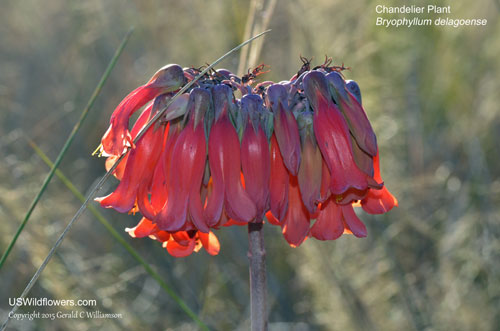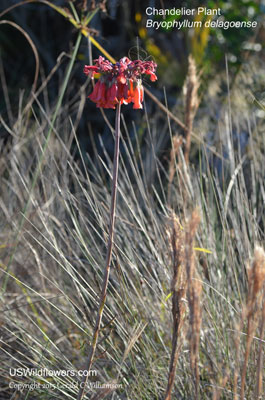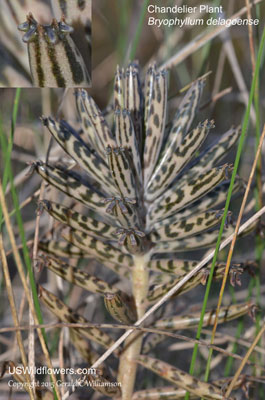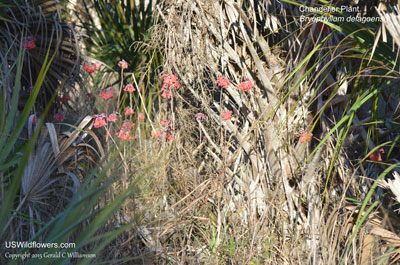Wildflowers of the United States | |||||||||||||
| |||||||||||||
Bryophyllum delagoense - Chandelier Plant, Common Mother of Millions, Mother of Thousands, Christmas bells, Tingo Tango. Bryophyllum is a genus of about 30 species of Madagascar and some of the other islands relatively nearby in the Indian Ocean. Bryophyllum was first described as a genus in 1805. In 1907 the French botanist Raymond Hamet made a case for integrating it within Kalanchoe, which itself was published in 1763. Since then some botanists treat it within Kalanchoe, while others maintain it as a separate genus. While the momentum currently seems to be toward integrating into Kalanchoe, partly because there are several species which have characteristics that could fit into either genus, Flora of North America and Weakley's Flora of the Southern and Mid-Atlantic States both treat Bryophyllum as a separate genus, so I will follow their lead.
| While there are no Bryophyllum native to North America, there are about 6 or 7 which have naturalized here, likely brought in as ornamentals. While they are invasive, they are restricted to tropical climates so have not spread far north, with Florida hosting all of them, and several found in a handful of other southern-tier states as well as Hawaii. Bryophyllum delagoense is the most widely distributed species in Florida, and is also found in Alabama, Texas, and Hawaii. There is a possibility that the species on this page is actually the hybrid Bryophyllum X houghtonii (Kalanchoe X houghtonii), based on a report from the park naturalist where this was photographed, but it appears to me to be closer to Bryophyllum delagoense in the shape of the leaves than the photographs I can find online for Kalanchoe X houghtonii. This plant is poisonous to livestock and humans and has significant adverse economic impact in some parts of the world, such as Africa and Australia. Some positive economic impact comes from its value as an ornamental, but if you live in a tropical or semi-tropical area, consider the possibility that this plant may be difficult to control before you use it as an outdoor ornamental. Synonyms: Kalanchoe delagoensis, Bryophyllum tubiflorum, Kalanchoe tubiflora Found in: AL, FL, HI, TX Leave comments on Bryophyllum delagoense at this link.   Blue=Native; Grey=Introduced Map from USDA Plants Database: USDA, NRCS. 2017. The PLANTS Database (http://plants.usda.gov, 03 Apr 2025). National Plant Data Team, Greensboro, NC 27401-4901 USA. Search Our Database: Enter any portion of the Scientific, Common Name, or both. Do a general Google search of the entire site: #ad #ad
| #ad
| | ||||||||||
|
Commercial / Cookie Notice Looking for Wildflowers for a specific state? Check here: | |||||||||||||
|
| |||||||||||||





